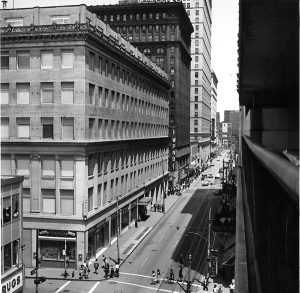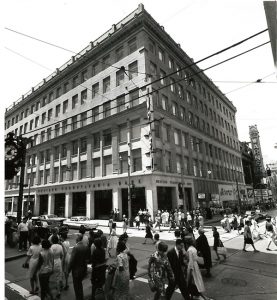
Architecture Feature: Frank & Seder Building
Frank & Seder Department Store, 441 Smithfield Street [1918-1954]
 On January 19, 2017, an article “Oxford abandons plans to build office tower” appeared in the Pittsburgh Post-Gazette on pp. A-1 and A-9. Author Mark Belko observed that Oxford Development Co. had given up plans for a “big iconic skyscraper in Downtown Pittsburgh” and had sold the property on Smithfield Street between Fifth and Forbes avenues to Stark Enterprises of Cleveland who “according to sources, intends to renovate the existing building––the former Frank & Seder department store. It sits across the street from the old Macy’s/Kaufmann’s department store, which also is being redeveloped.”
On January 19, 2017, an article “Oxford abandons plans to build office tower” appeared in the Pittsburgh Post-Gazette on pp. A-1 and A-9. Author Mark Belko observed that Oxford Development Co. had given up plans for a “big iconic skyscraper in Downtown Pittsburgh” and had sold the property on Smithfield Street between Fifth and Forbes avenues to Stark Enterprises of Cleveland who “according to sources, intends to renovate the existing building––the former Frank & Seder department store. It sits across the street from the old Macy’s/Kaufmann’s department store, which also is being redeveloped.”
With its history and architectural significance, the former Frank & Seder building is worth saving and adapting for new uses. As a contributing structure in a downtown National Register district, the stage is set for the developer to take advantage of the federal 20% investment tax credit for the “certified rehabilitation” of an income-producing property and/or receive benefits through the tax code by donating a preservation easement to a qualified recipient, such as the Pittsburgh History & Landmarks Foundation.
Historical and Architectural Significance
In 1907, Jacob H. Frank and Isaac Seder opened a store at 344 Fifth Avenue devoted to “ladies specialties.” In 1917 Frank & Seder began planning for a new, larger building in the 400 block of Smithfield Street. The store opened on May 21, 1918 and is a contributing structure in the expanded Pittsburgh Central Downtown Historic District (placed on the National Register May 2, 2013). The nomination form states:
“The seven-story building . . . was built . . . in a rather severe Classical Revival Style. The first story features polished stone walls framing large display windows, the second and third floors are grouped under fluted Ionic pilasters, and the fourth through sixth stories are simple brick walls with rectangular windows cut-out. The whole department store is capped like a renaissance palace with a projecting cornice and a recessed seventh story.”
Three architectural firms worked together on the building: Charles Bickel, MacClure & Spahr, and William E. Snaman.
Charles Bickel (1852-1921) designed many downtown commercial buildings, including the 1898 Kaufmann’s Department Store building across the street.
 The firm of MacClure & Spahr was formed in Pittsburgh in 1901 by Colbert A. MacClure (1879-1912) and Albert H. Spahr (1875-1966), graduates of M.I.T. in Cambridge, MA, the oldest architecture school in the USA. Their buildings include the Mon Incline Carson Street Station, the former Meyer, Jonasson & Co. store at 606 Liberty Avenue, and the home of George M. Laughlin, Sr. on Woodland Road, later owned by Andrew W. Mellon.
The firm of MacClure & Spahr was formed in Pittsburgh in 1901 by Colbert A. MacClure (1879-1912) and Albert H. Spahr (1875-1966), graduates of M.I.T. in Cambridge, MA, the oldest architecture school in the USA. Their buildings include the Mon Incline Carson Street Station, the former Meyer, Jonasson & Co. store at 606 Liberty Avenue, and the home of George M. Laughlin, Sr. on Woodland Road, later owned by Andrew W. Mellon.
The best-known Downtown building by William E. Snaman (1875-1953) is the former Donahoe’s Market and Restaurant with its imposing Classical colonnade, now occupied by CVS Pharmacy on Forbes Avenue between Market Square and Wood Street.
A collection of Seder Family Photographs, 1900-1940, is in the Rauh Jewish Archives at the Heinz History Center. Among the photos are “building construction, exterior and interior shots of the Frank & Seder store.” The collection guide can be read and downloaded on the Historic Pittsburgh website/Finding Aids.
